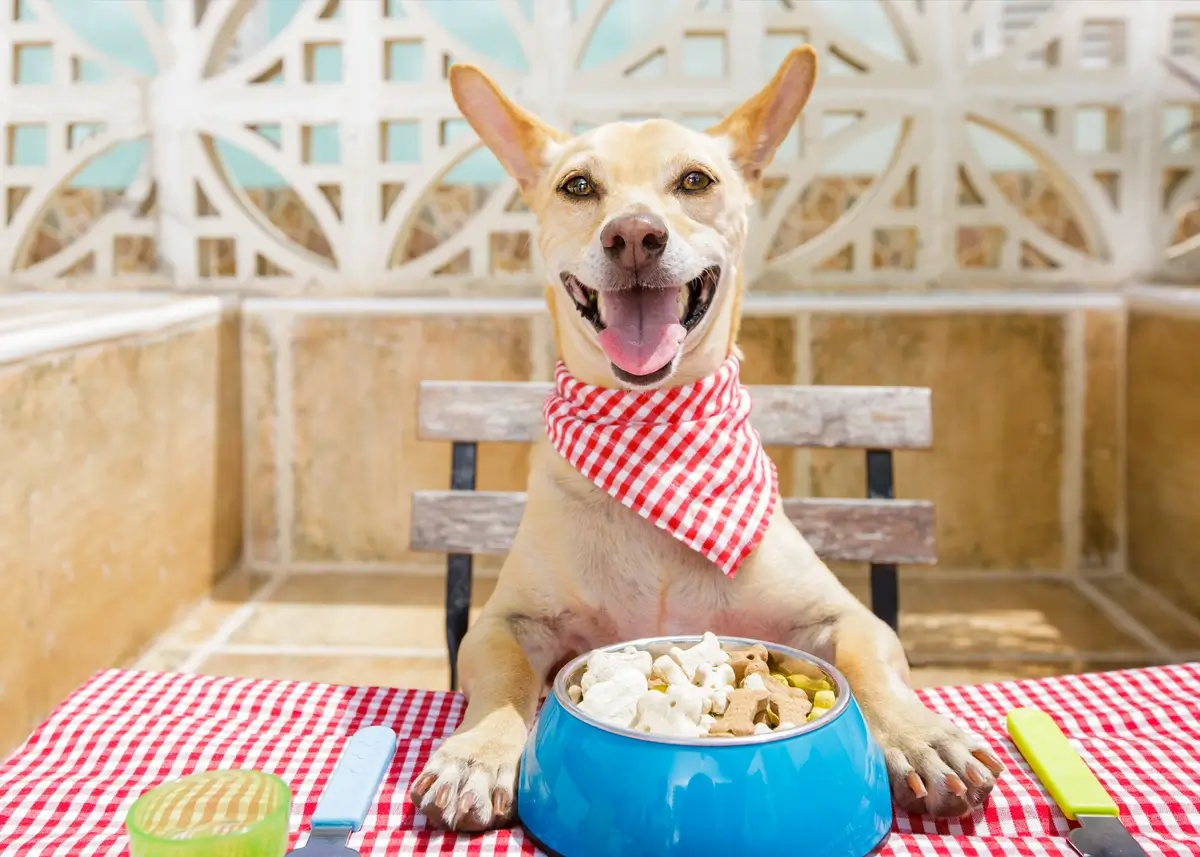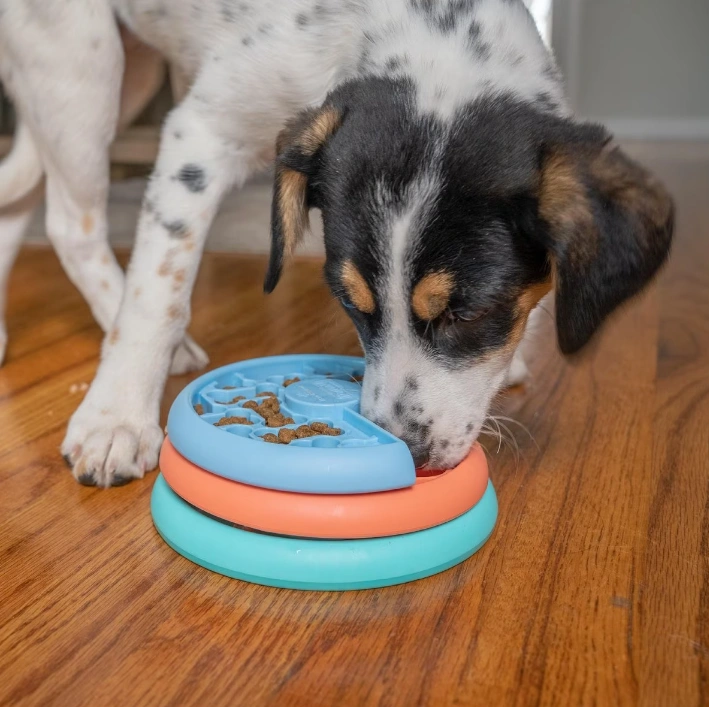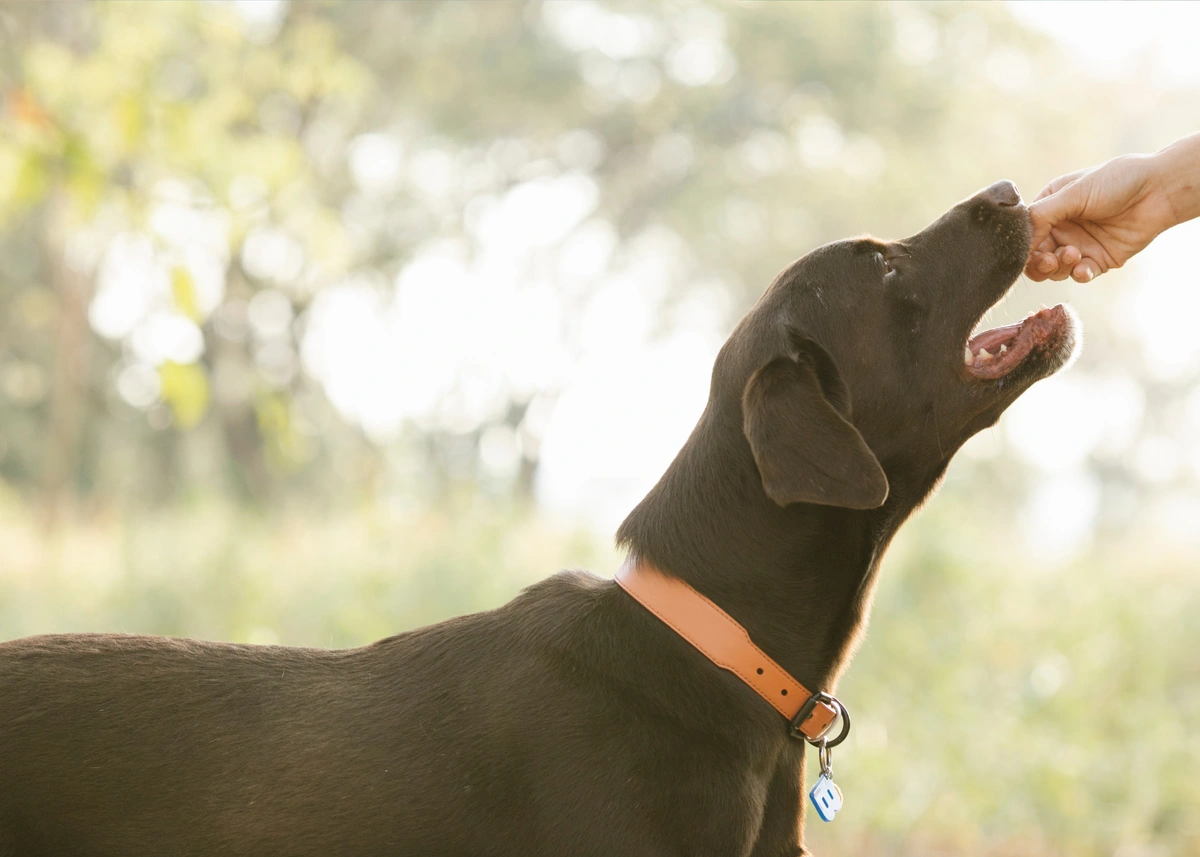Nibbler, Gobbler, Grazer, Chomper, Scarfer, Inhaler, Wolfer, Gulper.
No, these aren’t the nicknames of Santa’s new team of reindeer, but they sure could be! We’re talking about your puppy that eats his food too quickly!
All puppies are different when it comes to their eating habits. Some will turn up their noses at food and eat whenever they decide they’re ready. Others will calmly wait and eat their food as it is served. And then there’s the gobblin’ goblin puppy, the one that acts like you’ve never fed him a meal in his life. As you turn to fill up his water bowl, your puppy has inhaled the entire food bowl already!
Being a responsible puppy owner is knowing how to raise a happy, healthy puppy to live the best life possible with you. This entails many aspects, but you can do a few things to ensure healthy eating habits to avoid your puppy scarfing down their food and causing issues.
If you’re exasperated and thinking, “Help! My puppy eats too fast, so what do I do?” we’ve got some tips and tricks for you. Whether the solutions you want to try are behavior-based, DIY homemade, free, or purchased, here are some ways to slow down your puppy’s eating habits.
Why Does My Puppy Gulp Food?
There are all sorts of reasons why your puppy gulps down his food quickly, and some could be more severe than others. That’s why it’s always best to consult with your trusted licensed veterinarian to rule out any medical reason why the issue may be occurring.
Here are some medical reasons why your puppy may be inhaling their food too quickly:
- Cushing’s disease: Cushing's disease, also called hyperadrenocorticism, is a hormone problem that often affects dogs. It happens when the adrenal glands make too much cortisol. Eating too quickly can make Cushing's disease worse because it stresses the body more and might raise cortisol levels, which can cause more detrimental symptoms.
- Canine diabetes: Canine diabetes is a condition where a puppy’s body cannot properly regulate blood sugar levels. Fast eating can negatively impact canine diabetes as it leads to a rapid surge in blood sugar levels, making it harder for the body to maintain stable glucose levels and potentially worsening the symptoms and complications associated with the disease.
- Intestinal parasites: Nasty intestinal parasites in dogs can disrupt the digestive system and lead to poor nutrient absorption, causing nutritional deficiencies. This can result in increased hunger and overeating as the dog's body tries to compensate for the lack of essential nutrients.
What Are Some Consequences of My Puppy Eating Too Quickly?
If your puppy does not have any underlying medical issues, you may still be stumped about why your puppy eats so quickly. It’s great your puppy is in the clear, but there are still plenty of reasons why it’s important to monitor their feeding habits to prevent future problems and complications.
Digestive issues
Choking, heaving, vomiting, bloating, burping, and passing gas are all signs of digestive distress when your puppy eats too much too quickly. Your puppy can be unnecessarily uncomfortable, and you will not appreciate the “yerping and burping” that has you on edge to see if your puppy will fall ill or make a nasty mess for you to clean up.
Obesity
Obesity in dogs is a serious medical condition that can lead to severe health issues affecting all sorts of organs and body systems. Veterinarians have declared a pet obesity epidemic in the United States, and the statistics on pet obesity are alarming. According to the Veterinary Record, 37% of all puppies are overweight by the time they reach just 6 months old. However, you can help stop the statistic with proper feeding habits.
Puppy pawrents might assume their puppy is still hungry after they gobble up their food so quickly and begin to feed table scraps or treats. However, it’s dangerous to assume your puppy isn’t full and overfeed them unhealthy foods instead.
Bloat/GVD explained
Bloat, also known as gastric dilatation-volvulus (GDV), is a potentially life-threatening condition that occurs when your puppy’s stomach fills with gas, causing it to twist or rotate, which can lead to severe complications. A puppy’s pancreas and spleen can get caught up in the rotation, cutting off supply to vital organs, legs, and producing toxic gases.
Taking measures to slow down your puppy’s eating can possibly help prevent bloat. This condition is commonly seen in deep-chested dog breeds with a high height-to-width ratio, such as Great Danes, Doberman Pinschers, and German Shepherds. The exact cause of bloat is not fully understood, but factors like rapid eating, overeating, excessive exercise after a meal, or a genetic predisposition may contribute to its development.
Symptoms of bloat include a distended abdomen, restlessness, excessive drooling, unsuccessful attempts to vomit, and signs of discomfort. Bloat is a veterinary emergency, and immediate medical attention is crucial to relieve the pressure, correct the stomach rotation if present, and stabilize your puppy. Timely intervention is essential to increase the chances of a successful outcome and prevent life-threatening complications associated with bloat.
14 Ways to Slow Down Your Puppy’s Fast Eating Habits
If you have a fast eater, try some of these tips to slow down your puppy during meal times.
Many of these tips cater to a puppy’s need for mentally stimulating activities to keep their brains sharp. Some of these are free and are behavior changes or use items you already have around your house, while others are products you can purchase. Regardless of your budget, there are ways accessible to every puppy owner to help stop your puppy’s rapid feeding habits. You don’t always have to do these every feed, but you can get great results with consistency.
Stick to a feeding schedule
When trying to prevent your dog from gobbling down food, look at your own pet owner habits. Are you feeding your puppy at regular intervals, or only when you remember?
A puppy fed on a schedule will know when to anticipate feeding time based on their canine circadian rhythm, the body’s natural process where light regulates sleeping and waking habits. While they can’t tell time on an analog or digital clock like humans, your puppy learns the rhythm of the day.
A puppy fed regularly as part of your daily routine for your puppy will know when to anticipate feeding time and won’t wonder when their next meal will be if you don’t provide food at the same times every day.
Provide the best nutrition possible
Have you truly thought about the puppy food you feed your puppy? Do you buy the cheapest bag on sale? If you haven’t considered what’s in your puppy’s food, it may be time for a deep dive. Do your research together with your breeder and vet’s recommendation. The three of you together can determine what they’ve been fed for their first solids and help you continue to feed them nutritious high-quality puppy food according to the formulary.
Puppies need specially formulated food containing more vitamins, minerals, and fatty acids to help fuel their physical and mental growth and development. Puppy food instead of adult food will also be formulated for smaller teeth and catered to growing adult teeth.
Most puppies will need to eat 3 times a day until 4-6 months. During this time frame, you’ll need to investigate when to switch your puppy to adult food according to your puppy’s breed, size, teething stage, and behavior.
But if your puppy is eating too quickly, that’s not a good science-based excuse to switch your puppy to adult food.
Ditch the bowl
Try switching the container for feeding to something more spread out. An old rimmed cookie tin or large flat tray will help your puppy slow down when eating their puppy food serving.
Fix the scarcity mentality
Puppies who are fresh from their litter are spending the first few months adjusting to life without their mama and littermates. They may be used to jostling their siblings for a nursing spot or claiming a place at the food bowl when fed communally. Use some of these techniques suggested to rewire your puppy’s expectations around feeding times to show them they will have enough food instead of having to fight for it.
Feed multiple dogs separately
To expand on this idea of competing for food, you’ll need to pay attention to feeding time in a multiple-dog household. Try separating your furry friends during meal times to choose a calm spot to allow each dog to eat by themselves. This will hopefully reduce the competition mentality to scarf down their food first before the other dogs get it.
Work on training commands during meal times
Feeding times are great opportunities to teach and work on commands and manners. The commands “Sit,” “Wait,” and “Come” work well when teaching patience and delayed gratification. This can also help with jumping up and knocking the food bowl out of your hands.
Hand feed your puppy
Speaking of hands, why not hand feed your puppy if you have some extra time here and there? You’ll increase your bond with your puppy and can also work on teaching your puppy to be gentle when taking something from your hand.
Make it a game
Puppies love games, so give them a few food-focused games to play around the house. You can try Hide-and-Seek around the house where you stash the whole serving in a few different locations or set up a “breadcrumb” style pathway spaced out leading them on a fun, delicious trail.
Use a muffin tin in creative ways
Most households own a muffin tin, and if not, they’re easily purchased at a thrift store, yard sale, dollar store, or big box store. Divide your puppy’s food serving in the muffin cups. You can place large objects like tennis balls on top of the food in the cups to make it more fun. Flip the tin upside down and watch your puppy figure out how to flip it over to get to the tasty morsels hidden underneath. You could even put a few of the smaller 6-cup trays around the feeding area.
Snuff mats
A snuff mat is full of tall pieces of material that allow you to hide treats in between the pieces of fabric. You can easily take a serving size and hide them at different depths. Your puppy will use his nose to find lots of small rewards. The fun option is to make your own out of old tee shirts or you can purchase cute ones online or at your favorite pet store.
Slow feeding bowls
Whether you serve wet or dry food, a slow feeding bowl will definitely help slow down how quickly your puppy eats. Raised grooves and designs make it harder for a puppy to get food in their mouths which naturally slows them down as they work harder to eat.
Puzzle feeders
Puzzle feeders act the same way as slow feeder bowls to slow down eating and digestion, but they have components that require a puppy to actively move pieces to get to their food. Your puppy will love manipulating, sliding, pushing, and opening compartments or components to find a delicious reward.
Food dispensing toys
Puppies love playing and eating, so why not combine both? Several food dispensing toys can encourage focused eating in small amounts, and it makes dinner time more interesting for your puppy. It also helps you buy some time to dash around and get some things done!
Pre-programmable automatic feeder
If you have the budget for it and want to get high-tech, consider using a pre-programmable automatic feeder, especially for those with busy schedules or when you need to be out of the house for a period of time. You can set it to distribute small meals throughout the day to reduce the chance of issues caused by eating too quickly.
Feed a Pawrade Puppy
All this talk of feeding a puppy – but what if you don’t have a puppy yet? That’s where Pawrade can help! We partner with trustworthy breeders to provide you with happy, well-fed puppies for sale. Let us know if you see a roly-poly butterball of fluff that you’re interested in, and we can get you started on the easy journey of finding your furever food-loving pooch!







